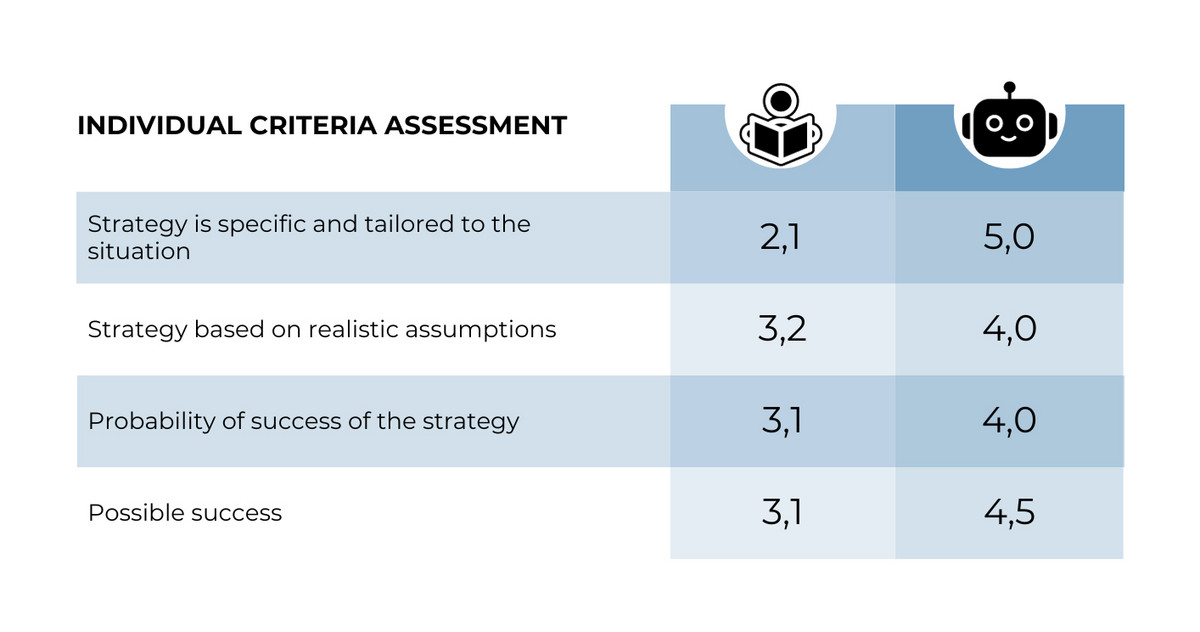Overview
Recommendations
Next Steps
Social media
What is AI capable of?
These days, no task seems too big for Artificial Intelligence (AI): in a matter of seconds, it drafts complex texts, analyzes financial data, and provides automated responses to customer queries – and more often than not, the output is surprisingly good. This seems to put many white-collar jobs at risk, and quite a few people are worried that machines might edge them out of their jobs.
But is AI capable of innovation as well? And does it possess entrepreneurial acumen, for instance when told to come up with an innovation strategy?
Nikolaus Franke, Academic Director of the MBA Entrepreneurship & Innovation, and his MBA students recently put AI to the test to find answers to these very questions.

Twenty-one MBA students of the Entrepreneurship & Innovation specialization were given a task that required entrepreneurial creativity to complete. They had to react to the dilemma of having an outstanding idea for innovation which, being a small company, they would be unable to protect. The scenario was based on the historical example of businessman Robert Taylor, who, by accident, had stumbled upon a promising innovation. Throwing spaghetti at the wall to see what sticks: this strategy employed by Taylor is about testing numerous ideas to find out which one works best, just the way only a small amount of the pasta thrown will remain stuck to the wall.
The students had five minutes to come up with a proposal for handling the situation. They were allotted so little time – about a second per word – to force them to start writing down their ideas right away, all but ruling out the possibility to think and reflect. These extreme time constraints were a conscious decision to create similar conditions for the students and ChatGPT. There is no doubt that with less time pressure, more elaborate solutions would have been possible.
As expected, ChatGPT completed the task very quickly. However, it took several revisions to arrive at an acceptable solution: at 340 words, the first response was significantly longer than permitted. When prompted again to come up with a solution in no more than 200 words, the cheeky machine delivered 233 words! A stern reprimand served to subdue the AI, just as it would a human: the next solution consisted of only 135 words and was shorter than asked for. But ChatGPT’s feelings were not hurt for long. The friendly reminder that it could go ahead and use as many as 200 words resulted in a solution that, again, was too elaborate at 216 words. It took a fifth version to get close to the specified word count (183 words).
Two researchers with years of experience in the field of entrepreneurship and innovation were asked to evaluate the solutions put forward. The answers had been anonymized so that it was unclear whether they had been penned by students or ChatGPT.
The assessors also weren’t aware of the context of the experiment (a comparison between human and AI abilities). Independently, they rated the solutions in a quantitative manner in five categories.
... was crystal-clear (rating scale from 1 = very good to 5 = very poor):

The ratings also differed markedly across all categories investigated: the MBA students did a better job at producing a specific strategy tailored to the situation (MBA students: 2.1, ChatGPT: 5.0); the assumptions they based their strategy on were more realistic (MBA students: 3.2, ChatGPT: 4.0); their strategy was deemed more likely to succeed (MBA students: 3.1, ChatGPT: 4.0), and also their potential success was greater (MBA students: 3.1, ChatGPT: 4.5).
All in all, every single one of the 21 MBA students participating in the experiment produced a better strategy than ChatGPT, outdoing the AI app across all categories. This is quite a feat considering that ChatGPT’s solution took five attempts and the students had to come up with spontaneous solutions under unrealistically harsh conditions.
AI, as it turns out, is simply no match for the MBA students’ business acumen.
Because the main threat is the big competition and small entry barriers in a simple product, a good strategy would be to partner with one or more distribution chains like retail companies, big enough to take as much of the market as soon as possible before the competition has time to react and brand it as much as possible as the original and innovate product in the market. Then when competition starts they can still hold a big % of the market because their brand is already well known.
Minnetonka Corporation's winning innovation strategy should encompass several key elements: Continuous Innovation: Prioritize rapid product development and improvements to stay ahead of imitators. Customer-Centric Focus: Tailor products to customer needs and preferences through active feedback channels. Strategic Alliances: Form partnerships with non-competing companies to expand distribution and leverage their resources.
Robust Branding: Invest in branding and marketing efforts to create a unique identity and build customer loyalty. Product Diversification: Expand into related personal-care product categories to reduce risk and broaden the customer base. Digital Presence: Establish a strong online presence, including e-commerce capabilities, to reach customers directly. Operational Efficiency: Streamline operations to maintain competitive pricing. Legal Protection: Utilize trademarks, trade secrets, and other legal measures to safeguard unique formulations. Sustainability Initiatives: Embrace eco-friendly practices to appeal to environmentally conscious consumers. Market Agility: Stay vigilant about market trends and adapt strategies swiftly to changes in the competitive landscape. By implementing these strategies, Minnetonka can navigate patent challenges, deter imitation, and compete effectively with stronger competitors while achieving sustainable growth in the personal-care products market.
Robert Taylor was not as pressed for time as the experiment’s MBA students – and for him, much more was at stake. He went for a kind of “all-in” strategy that he knew the established companies would be hesitant about. To win enough time to establish his brand, he further extended this time frame by taking a tremendous risk and buying up all pump dispensers around the world. Once the overwhelming success of his innovation began to show, it was simply too late for the big players to copy his product. The lucrative sale of his company later turned him into a multi-millionaire.
AI’s poor performance in a direct comparison with human entrepreneurs should not be misinterpreted. Generative AI models such as ChatGPT constitute a fundamental innovation with true disruptive potential in themselves, which makes them extremely salient – particularly for entrepreneurs.
Numerous work steps that are part of business processes can be realized in a better, faster, and less error-prone way thanks to AI. For this reason, AI tools are not contested in the WU Executive Academy’s MBA programs; instead, students are encouraged to creatively engage with them.
Join 15,000 + professionals and get regular updates on leadership and management topics. Learn something new every time.